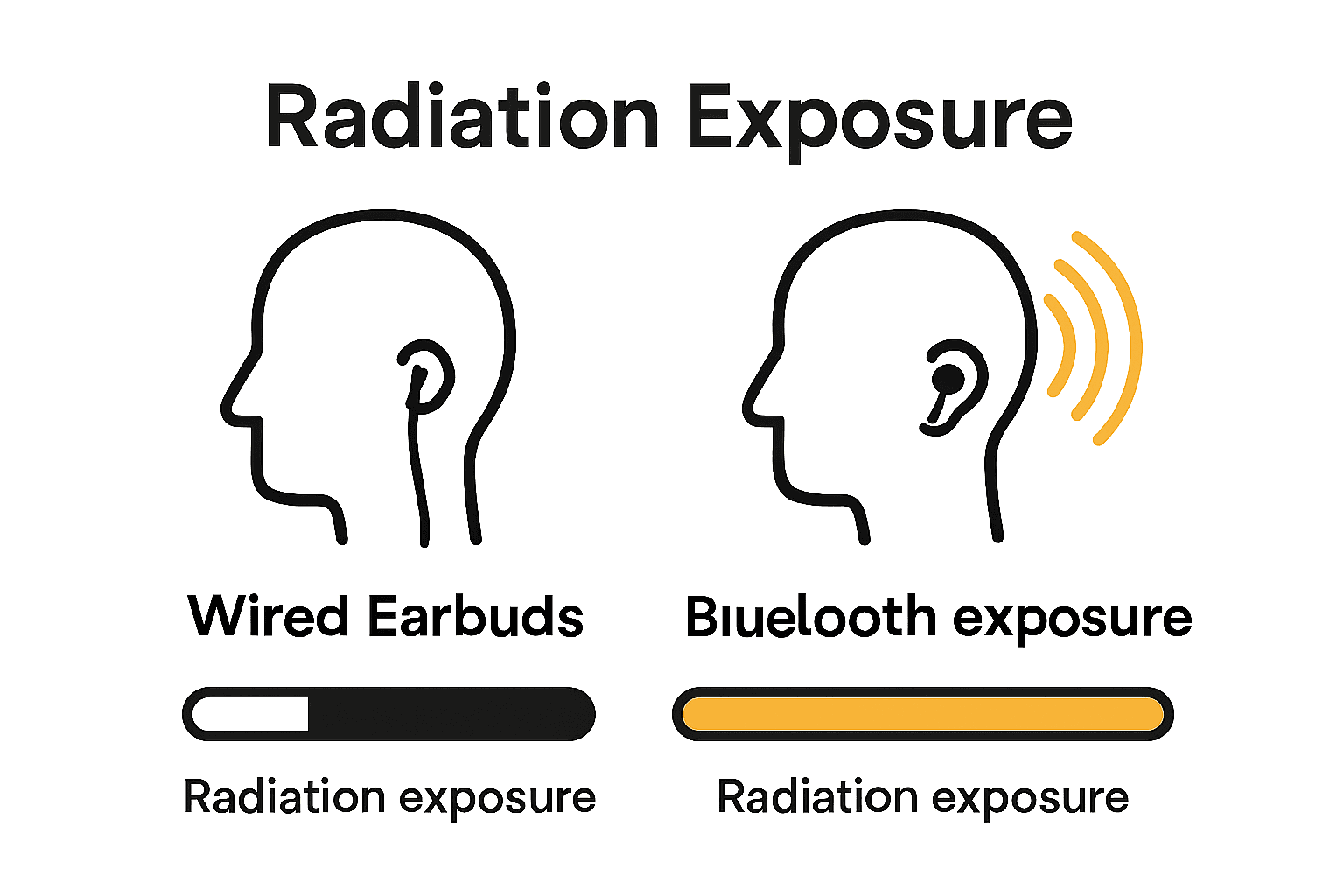Bluetooth earbuds are everywhere now, turning hours of music, podcasts, and calls into wire-free bliss. It seems harmless enough, especially with over 400 million pairs sold every year worldwide. But get this. Every time you slip them in, you are putting a radio device millimeters from your brain. What most people miss is how different that direct exposure is compared to simply holding a phone or using a speaker, and why that matters way more than you might think.
Table of Contents
Quick Summary
| Takeaway | Explanation |
| Understand Bluetooth earbud technology | Bluetooth earbuds operate through short-range radio frequencies, allowing wireless audio streaming from devices within 10 meters. |
| Proximity increases health concerns | Wearing earbuds close to the ear canal raises potential risks from prolonged exposure to low-level electromagnetic radiation. |
| Protect children from wireless exposure | Young users are more vulnerable to electromagnetic radiation, necessitating parental awareness to mitigate potential developmental impacts. |
| Wireless connection affects overall wellness | Continuous use of Bluetooth earbuds may lead to systemic stress responses and subtle neurological effects that deserve attention. |
| Stay informed about electromagnetic safety | Understanding the implications of wireless technologies is essential for making informed choices about their usage and personal health. |
What Are Bluetooth Earbuds and How Do They Work?
Bluetooth earbuds represent a modern wireless audio technology that has revolutionized personal sound experience. These tiny devices connect wirelessly to smartphones, laptops, and other compatible electronics, allowing users to listen to music, podcasts, and take calls without the traditional wired constraints.
The Basic Technology Behind Bluetooth Earbuds
At their core, Bluetooth earbuds operate using short-range radio frequency communication. As Britannica explains, these devices utilize a specific wireless protocol that transmits audio signals across short distances, typically within 10 meters. The technology enables a direct communication channel between your audio source and the earbuds, creating a seamless listening experience.
How Bluetooth Signal Transmission Works
The transmission process involves complex but efficient technological mechanisms. Bluetooth earbuds use the 2.4 GHz ISM radio band to establish a connection, which allows for quick pairing and stable audio streaming. These devices continuously exchange digital data packets, converting sound into electrical signals that can be wirelessly transmitted and then reconverted into audio you can hear.
Key components of Bluetooth earbud functionality include:
-
Wireless Transmitter: Converts audio signals into radio waves
-
Receiver: Captures and decodes radio signals back into sound
-
Battery: Powers the wireless transmission and audio playback
While convenient, these wireless technologies raise important questions about potential electromagnetic radiation exposure and its long-term health implications. Understanding how Bluetooth earbuds function provides crucial insight into their potential risks and technological complexity.
The Health Risks of Bluetooth Radiation Exposure
Bluetooth earbuds emit electromagnetic radiation that raises significant concerns about potential long-term health impacts. While convenient, these wireless devices expose users to continuous low-level radiofrequency radiation directly near sensitive brain and ear tissues.
Understanding Electromagnetic Radiation Exposure
Radiofrequency radiation from Bluetooth devices operates in the non-ionizing spectrum, which means it does not directly damage cellular DNA like high-energy ionizing radiation. However, research from the American Cancer Society suggests that long-term exposure may have subtle biological effects not yet fully understood by scientific consensus.
Potential Biological Impacts of Continuous Exposure
Prolonged use of Bluetooth earbuds presents several potential health concerns:
-
Thermal Effects: Radiation can generate minor heat in body tissues
-
Cellular Stress: Potential disruption of normal cellular processes
-
Neurological Interactions: Possible interference with brain wave patterns
Scientists are particularly concerned about proximity risks. Unlike traditional cell phones held at a distance, Bluetooth earbuds sit directly inside the ear canal, potentially increasing radiation absorption near critical neurological structures.

Additionally, read more about wireless radiation risks to understand the broader implications of constant wireless technology exposure. The human body’s electrical system may be more sensitive to these artificial electromagnetic frequencies than previously recognized, making continued research and cautious approach essential.
How Bluetooth Technology Interacts with the Human Body
Bluetooth technology represents a complex electromagnetic interaction with human biological systems, introducing artificial frequencies into our natural electrical environment. Understanding these interactions reveals potential risks beyond simple convenience of wireless communication.
Electromagnetic Energy Absorption Mechanisms
According to the Federal Communications Commission, Bluetooth devices emit low-power radiofrequency energy that gets absorbed by bodily tissues. The human body essentially acts like an antenna, receiving and processing these artificial electromagnetic signals in ways not fully comprehended by current scientific understanding.
Biological Response to Artificial Frequencies
The human body operates through intricate electrical signals. When exposed to external electromagnetic radiation from Bluetooth devices, several potential interactions occur:
-
Cellular Membrane Disruption: Potential interference with cell membrane electrical properties
-
Metabolic Process Alteration: Possible changes in cellular energy production
Proximity Amplifies Potential Risks. Bluetooth earbuds positioned directly in ear canals create an unprecedented proximity of electromagnetic radiation to sensitive neurological structures. This close contact means radiation penetrates deeper into bodily tissues compared to traditional communication devices.
Our bodies have evolved complex electrical communication systems over millions of years, and these artificial frequencies represent a relatively new environmental challenge. Discover more about protecting yourself from electromagnetic radiation to understand the broader implications of constant wireless technology exposure. The long-term consequences of these interactions remain an active area of scientific investigation.
Why Parents Should Be Concerned About Bluetooth Earbuds
Parents face unprecedented challenges in protecting their children from emerging technological risks. Bluetooth earbuds represent a significant concern due to their constant proximity to developing brains and vulnerable biological systems of children and teenagers.
Developmental Vulnerability of Young Bodies
Research from the National Institute of Environmental Health Sciences highlights that children’s developing bodies are significantly more susceptible to environmental electromagnetic exposures. Their thinner skull structures and rapidly dividing cells make them more vulnerable to potential radiation impacts compared to adults.

Cumulative Exposure Risks for Young Users
Children and teenagers increasingly use Bluetooth earbuds for extended periods, creating long-term exposure scenarios that could have significant health implications:
-
Neurological Development: Potential interference with brain cell communication
-
Cellular Stress: Higher risk of electromagnetic radiation absorption
-
Developmental Disruption: Possible alterations in normal physiological processes
Critical Parental Awareness: The consistent, close-proximity radiation exposure from Bluetooth earbuds differs dramatically from occasional device interactions.
To clarify the unique health concerns posed by Bluetooth earbuds compared to traditional audio devices, the following comparison table highlights key exposure characteristics and risks.
| Aspect | Bluetooth Earbuds | Traditional Wired Headphones | Speakerphone/External Speaker |
| Proximity to Brain | Directly inside ear canal | Over or on ears | Distant from head |
| Type of Radiation | Continuous low-level RF | No wireless radiation | Minimal (if any) |
| Cumulative Exposure | High (when worn for hours) | Low | Very low |
| Vulnerability for Kids | Greatest due to proximity | Lower | Lowest |
| Potential Effects Noted | Cellular stress, neurological | Minimal | Negligible |
Learn more about EMF protection strategies for children to understand comprehensive approaches to minimizing potential technological health risks. Parents must remain vigilant and proactive in understanding and mitigating emerging technological health challenges facing younger generations.
The Impact of Wireless Earbuds on Our Overall Wellbeing
Wireless earbuds have transformed personal audio experiences, yet their profound impact on human physiological and psychological wellness remains critically underexplored.
This table summarizes potential physiological and neurological responses to continuous electromagnetic exposure from wireless earbuds, as discussed in the article.
| Response Type | Description (as related to Bluetooth Earbuds) |
| Thermal Effects | Minor tissue heating from radiofrequency radiation |
| Cellular Stress | Disruption of normal cellular processes; increased biological strain |
| Attention Issues | Possible interference with cognitive processing and focus |
| Emotional Impact | Subtle alterations in neurotransmitter balance, affecting mood |
| Stress Hormones | Potential changes in cortisol/adrenaline production and stress response |
| Developmental Risk | Higher risk in children due to developing neurological systems |
Physiological Stress Responses
According to research published in Electromagnetic Biology and Medicine, continuous exposure to electromagnetic frequencies can trigger systemic stress responses in human bodies. Wireless earbuds create sustained electromagnetic interactions that may generate subtle but persistent biological reactions, potentially overwhelming our natural cellular communication mechanisms.
Psychological and Neurological Implications
Constant wireless connectivity introduces complex psychological dynamics that extend beyond simple audio consumption. Continuous electromagnetic exposure potentially influences neurological functioning through several mechanisms:
-
Attention Disruption: Potential interference with natural cognitive processing
-
Stress Hormone Activation: Possible changes in cortisol and adrenaline production
-
Emotional Regulation: Potential subtle alterations in neurotransmitter balance
Holistic Health Perspective: Wireless earbuds represent more than technological accessories they are active agents continuously interacting with our delicate biological systems. Learn strategies for managing wireless radiation exposure to understand comprehensive approaches to maintaining wellness in our increasingly connected world. The long-term consequences of these interactions remain an emerging field of critical scientific investigation.
Protect Yourself from the Hidden Dangers of Bluetooth Earbuds
Are you worried about the effects of electromagnetic radiation from Bluetooth earbuds on your health? This article made it clear that sitting wireless devices so close to sensitive areas like the brain and ear canal allows EMF exposure to build up every day. Many people are searching for ways to reduce the risks of thermal effects, cellular stress, and long-term neurological consequences described throughout this article. If you want your family to stay protected from these invisible dangers, you are not alone and there are proven solutions available.

Do not wait until you notice symptoms of EMF stress. Take action now and explore how Omnia Radiation Balancer uses scientifically tested technology to neutralize electromagnetic field radiation from wireless devices, including Bluetooth headphones. See how you can protect your children from EMF and understand why you need to guard your wellbeing from EMF fields. Learn how real users have regained peace of mind through these reliable EMF shields for today’s wireless world. Visit Omnia Radiation Balancer and make the smart choice for lasting health and safety.
Frequently Asked Questions
What are the health risks associated with Bluetooth earbuds?
Bluetooth earbuds emit low-level electromagnetic radiation that may pose potential health risks such as cellular stress and neurological interference. To mitigate these risks, limit daily use to avoid prolonged exposure, aiming for less than one hour per day when possible.
How can I reduce my exposure to Bluetooth radiation while using earbuds?
To minimize your exposure, consider using the earbuds for short periods and take frequent breaks. For instance, after every hour of use, take a break of at least 10-15 minutes to lower your overall exposure.
Are Bluetooth earbuds safe for children to use?
Bluetooth earbuds can present significant health concerns for children due to their developing brains and bodies, which are more vulnerable to electromagnetic exposure. To protect young users, limit their use to occasional listening sessions and educate them about taking breaks.
What should I look for in alternatives to Bluetooth earbuds?
When seeking alternatives, consider wired headphones or earphones that eliminate electromagnetic radiation exposure entirely. Prioritize options that are comfortable for extended use and check for quality sound to enhance audio experiences.
How does prolonged use of Bluetooth earbuds affect my overall wellbeing?
Extended use of Bluetooth earbuds can create physiological stress responses and disrupt cognitive functions, potentially leading to attention issues and emotional regulation problems. To safeguard your wellbeing, monitor your usage habits and aim to limit Bluetooth earbuds to specific tasks rather than continuous use throughout the day.
What are some practical strategies to manage Bluetooth radiation exposure?
Practical strategies include using speakerphone settings or a wired headset for longer calls and turning off Bluetooth when not in use. By adopting these habits, you can significantly reduce your average daily exposure to Bluetooth radiation, making a noticeable difference over time.
Recommended
-
Are Wireless Headphones or Earbuds Dangerous? – Omnia Radiation Balancer
-
Cell Phone Radiation: Do Cell Phones cause Cancer? – Omnia Radiation Balancer
-
Common EMF-Producing Devices: Understanding EMF Sources – Omnia Radiation Balancer
-
Cell Phone Radiation Effects on Human Body - Omnia Radiation Balancer



Share and get 15% off!
Simply share this product on one of the following social networks and you will unlock 15% off!